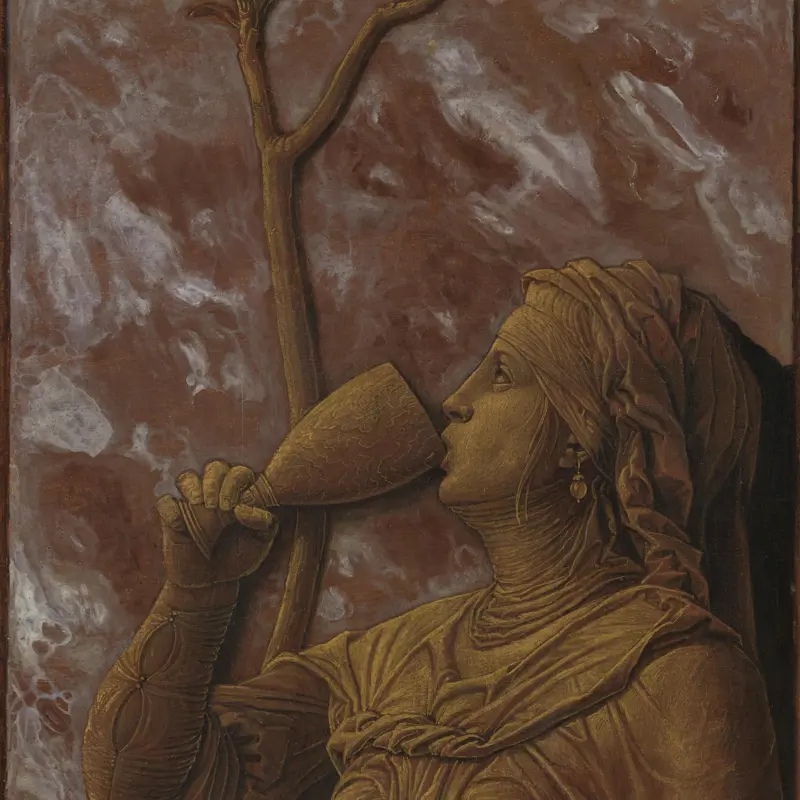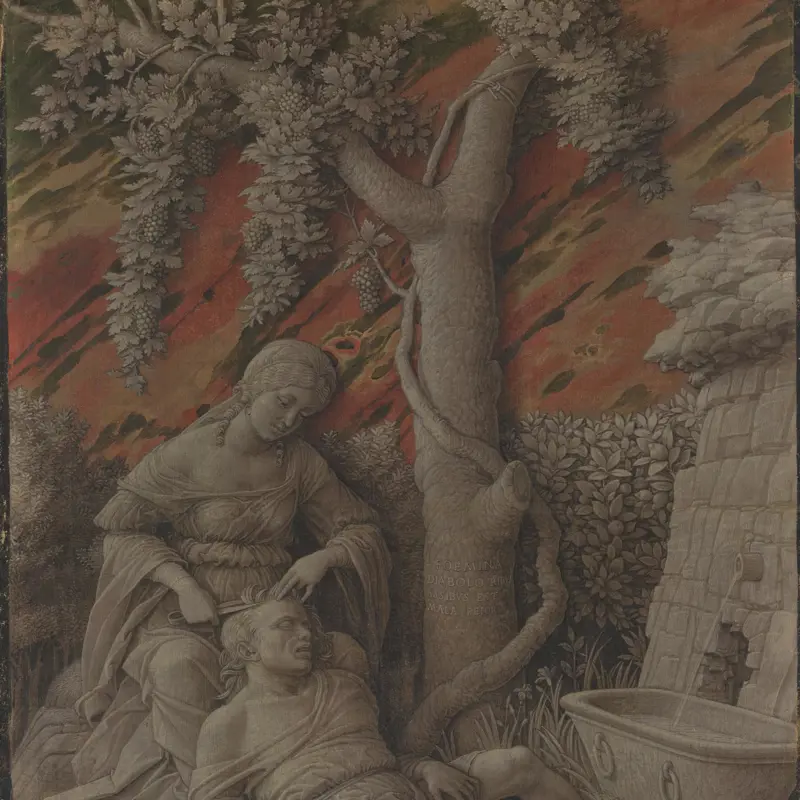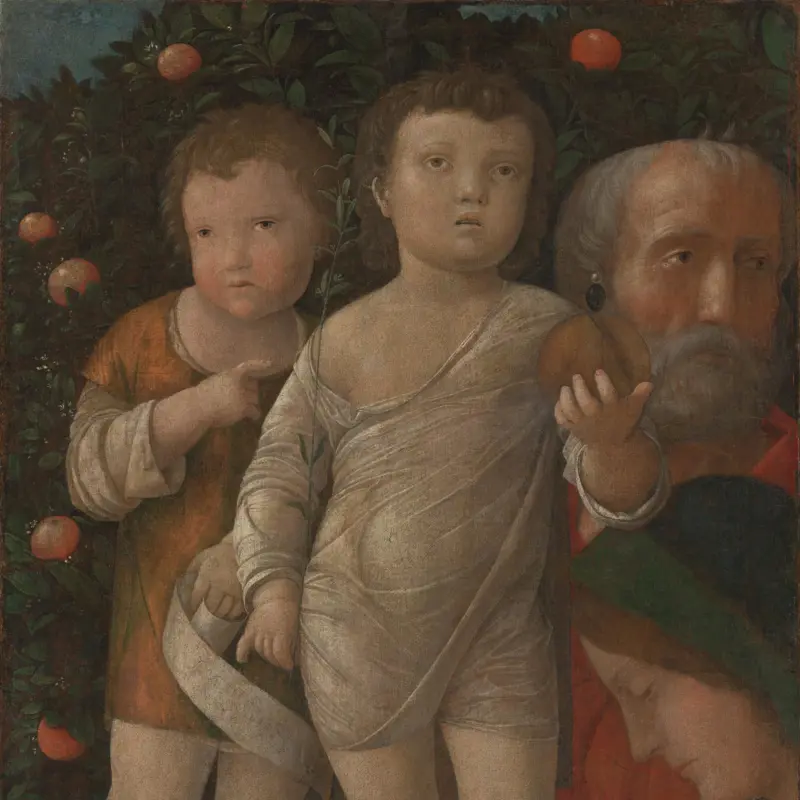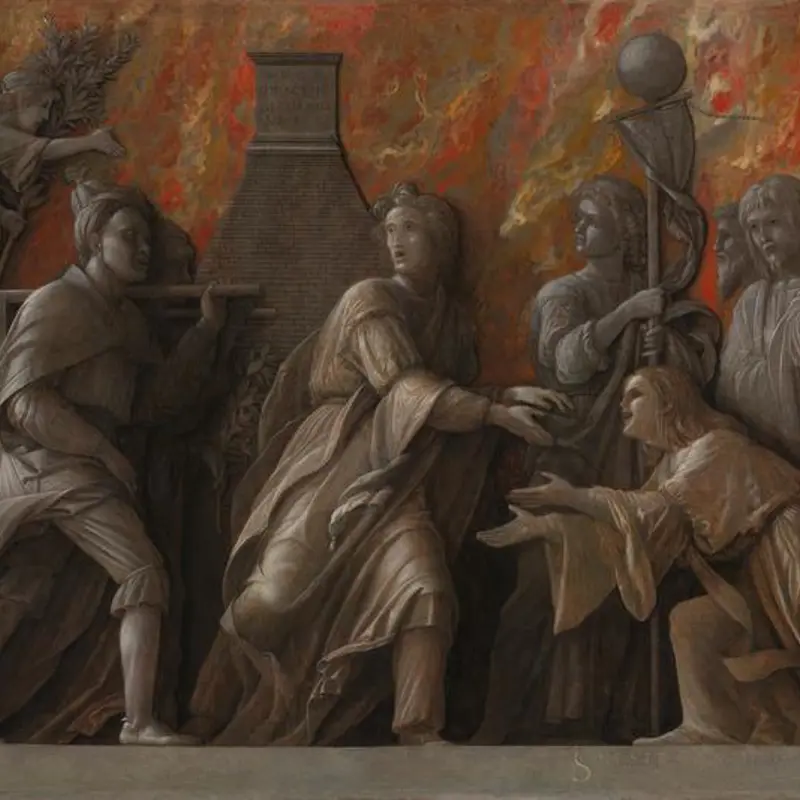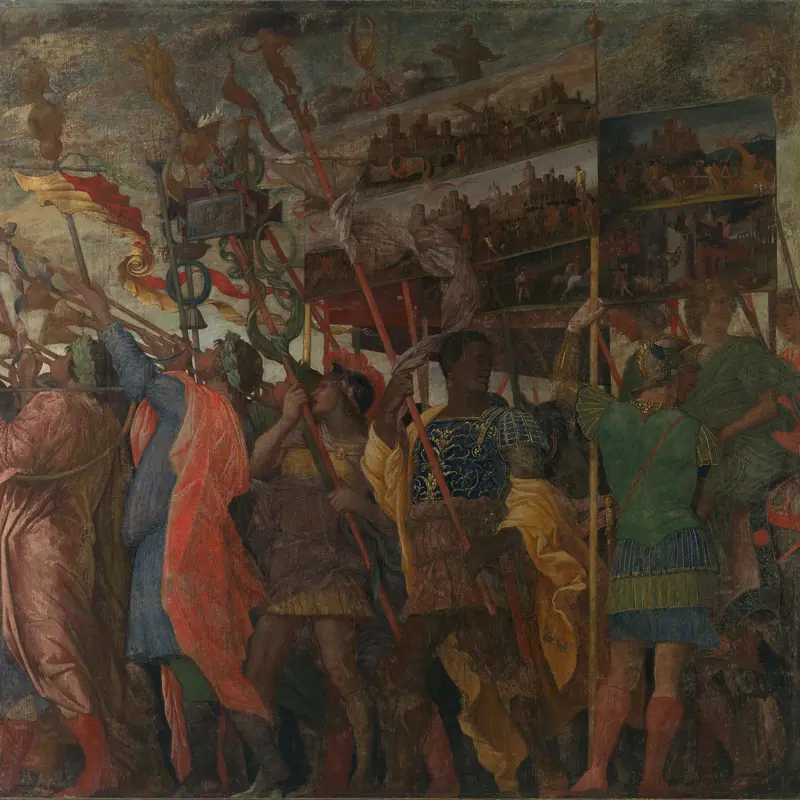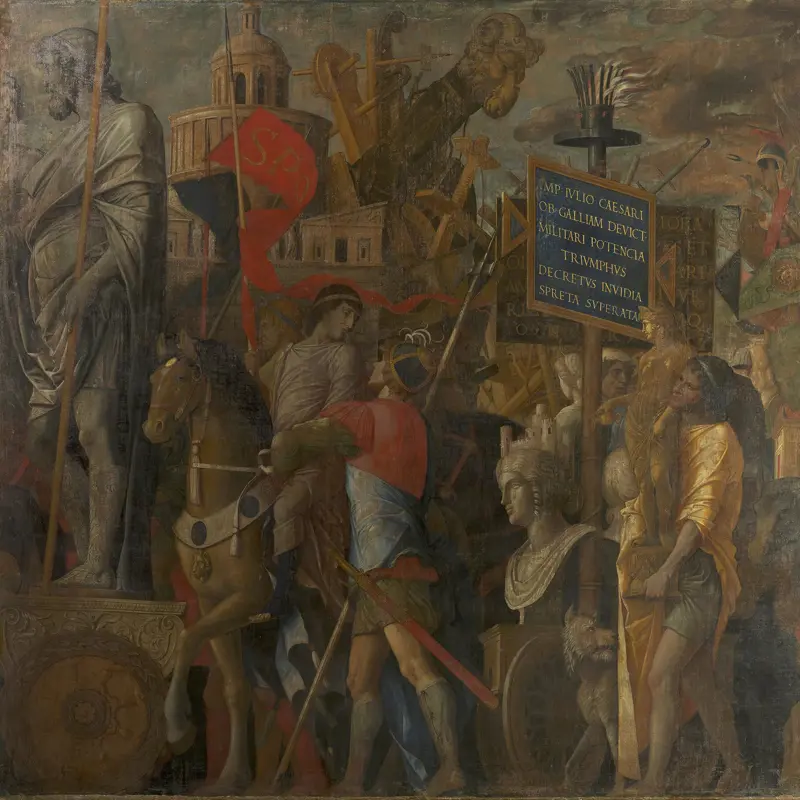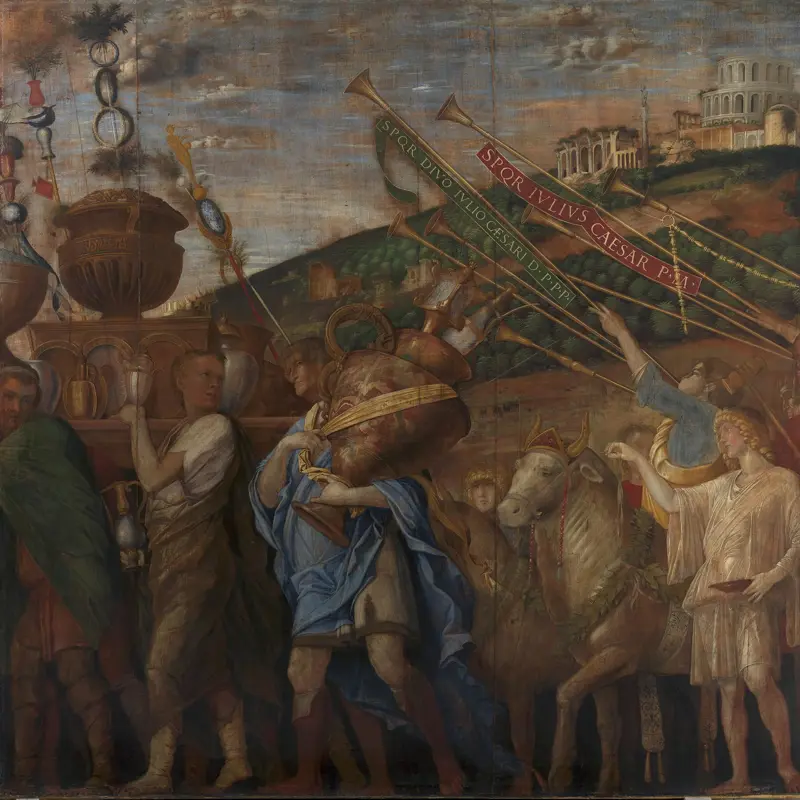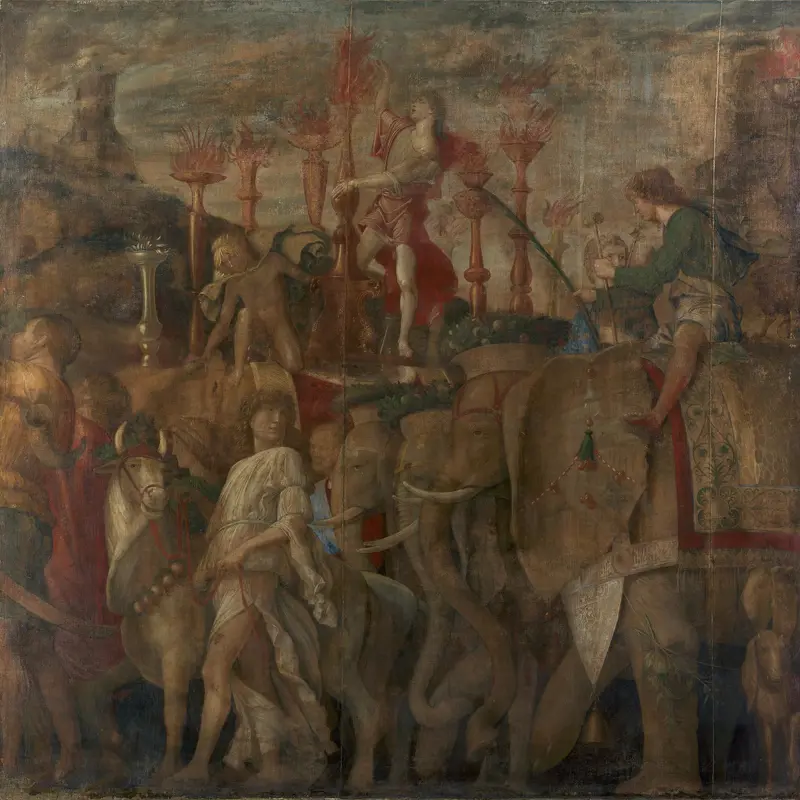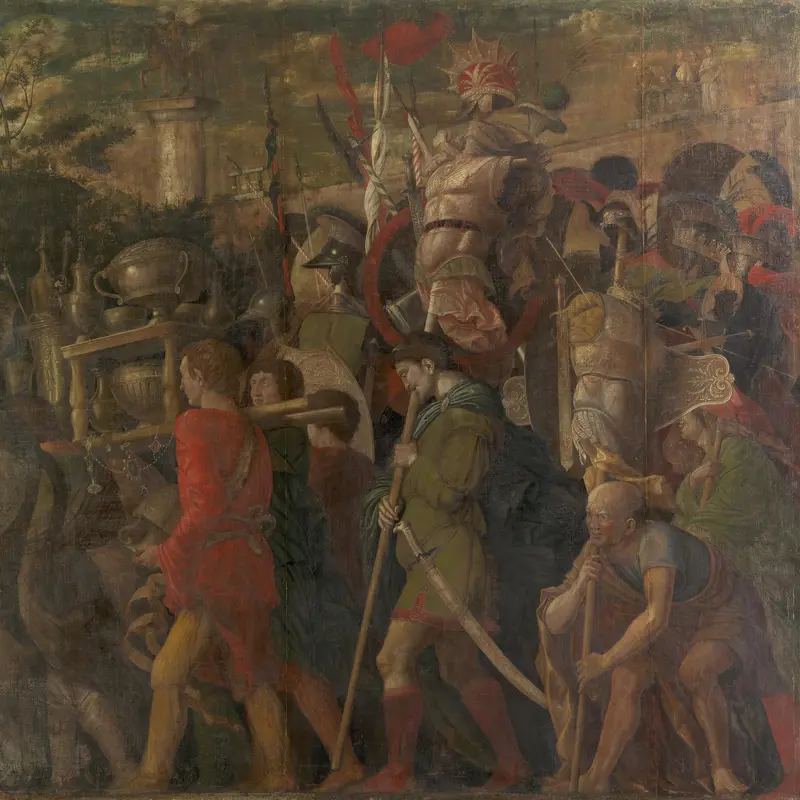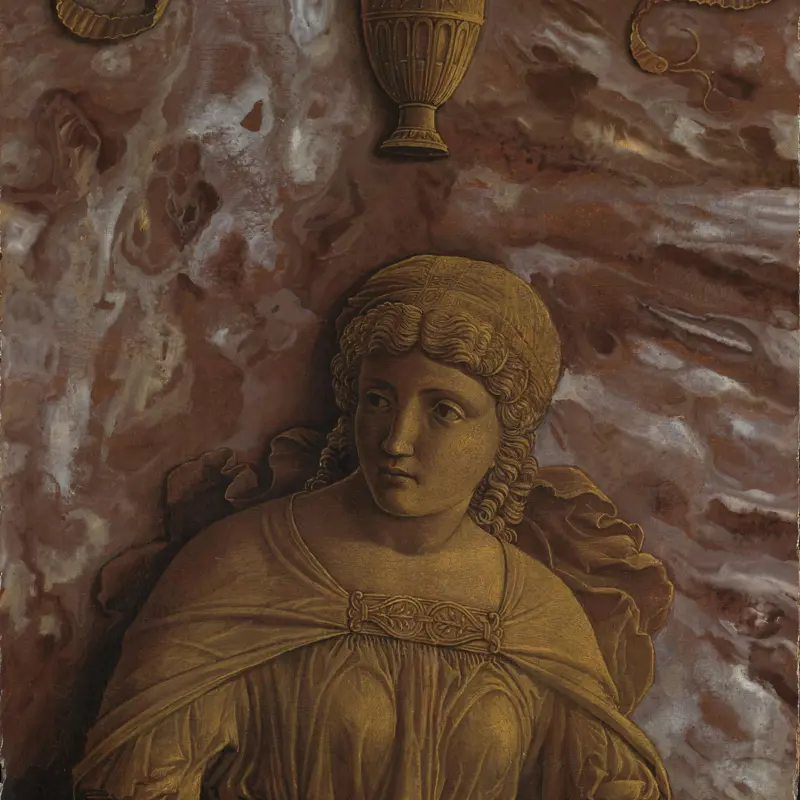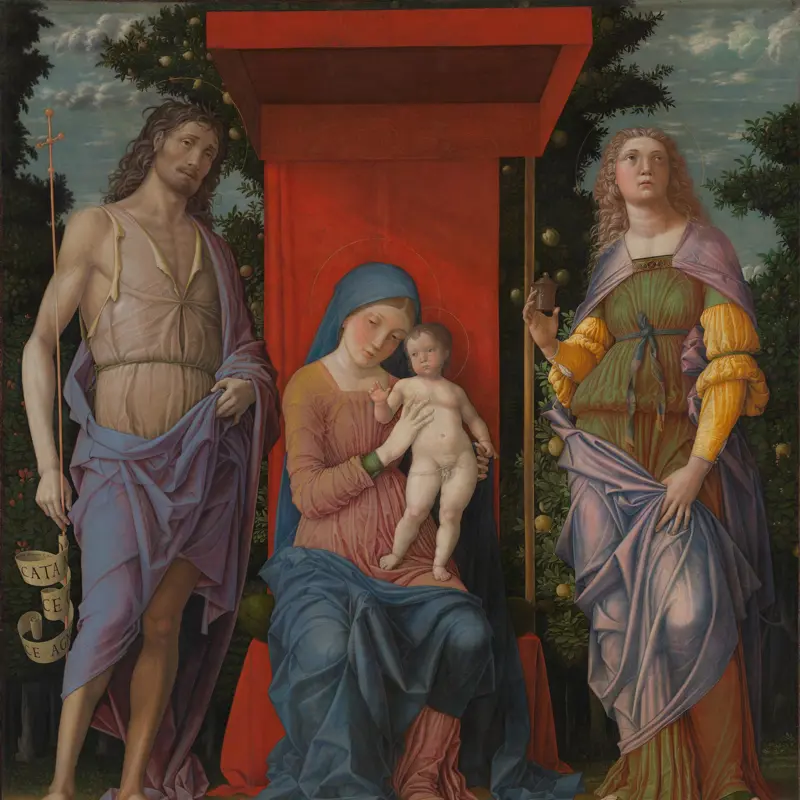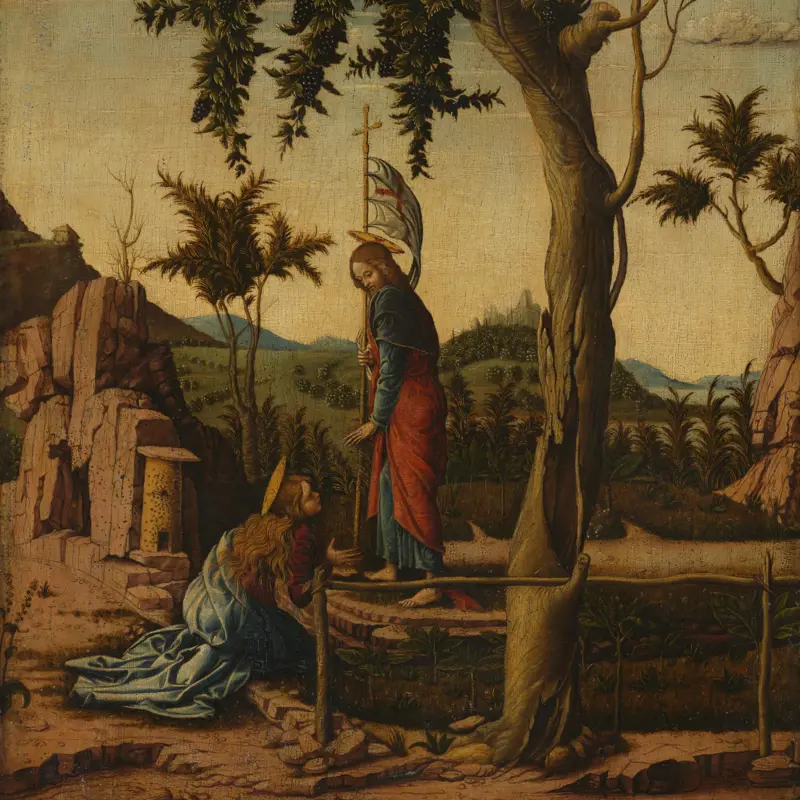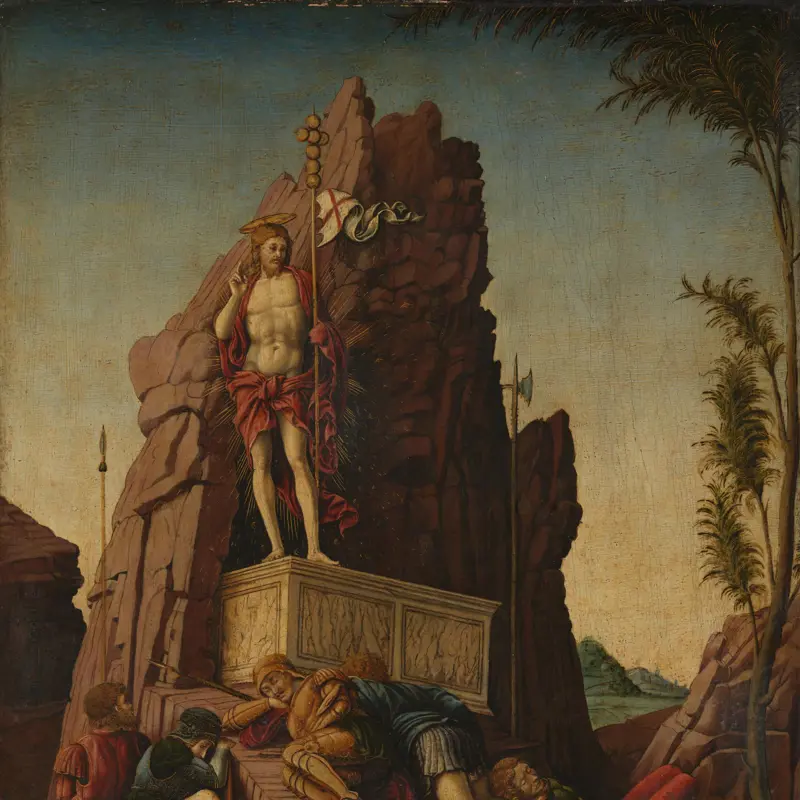Andrea Mantegna, 'The Agony in the Garden', about 1455-6
About the work
Overview
Christ prays before a group of cherubs who hold up the instruments of his torture and death. His disciple Judas, who has betrayed him, leads a large band of soldiers down from Jerusalem to arrest him. Meanwhile his other disciples sleep.
This painting reflects many of the artistic issues that would preoccupy Mantegna throughout his career. He was fascinated by the art of classical antiquity: the disciples here look like statues of Roman emperors in togas. One lies with his legs facing straight out at the viewer, a difficult pose to paint; Mantegna enjoyed experimenting with it for its ability to draw us into the picture.
He skilfully uses the landscape setting to tell the story in a single image, the march of the soldiers from the city gates creating drama and suggesting the passage of time. He uses his favoured fast-drying egg tempera paint (pigments bound with egg) to describe minute details like the individual bricks of the city walls.
Key facts
Details
- Full title
- The Agony in the Garden
- Artist
- Andrea Mantegna
- Artist dates
- About 1431 - 1506
- Date made
- About 1455-6
- Medium and support
- Egg tempera on wood
- Dimensions
- 62.9 × 80 cm
- Inscription summary
- Signed
- Acquisition credit
- Bought, 1894
- Inventory number
- NG1417
- Location
- Room 63
- Collection
- Main Collection
- Frame
- 15th-century Venetian Frame
Provenance
Additional information
Text extracted from the ‘Provenance’ section of the catalogue entry in Martin Davies, ‘National Gallery Catalogues: The Earlier Italian Schools’, London 1986; for further information, see the full catalogue entry.
Exhibition history
-
2008Mantegna, 1431-1506Musée du Louvre26 September 2008 - 5 January 2009
-
2018Mantegna and BelliniThe National Gallery (London)1 October 2018 - 27 January 2019
-
2018Mantegna and Bellini: Masters of the RenaissanceGemäldegalerie (Berlin)1 March 2019 - 30 June 2019
-
2021The Director's Choice: Lizards, Fancy Feathered Hats and TrickeryThe National Gallery (London)5 May 2021 - 9999
Bibliography
-
1841Catalogue des tableaux composant la galerie de feu son eminence le Cardinal Fesch, Rome 1841
-
1845F. Villot, 'Vente de la galerie Fesch à Rome', Le Cabinet de l'amateur, IV, 1845, pp. 138-44
-
1845George, Galerie de feu S.E. le Cardinal Fesch, ancien archevêque de Lyon, primat des Gaules, etc., etc., ou catalogue raisonné des tableaux de cette galerie, accompagné de notices historiques et analytiques, Rome, 17 March 1845 - 18 March 1845
-
1849Christie & Manson, Catalogue of the Very Choice and Important Collection of Italian Pictures, together with Four Capital English Works: The Property of William Coningham Esq., London, 9 June 1849
-
1853National Gallery, Report from the Select Committee on the National Gallery, together with the Proceedings of the Committee, Minutes of Evidence, Appendix, and Index, London 1853
-
1853London, National Gallery Archive, NG15/3: Report from the Select Committee on the National Gallery, together with the Proceedings of the Committee, Minutes of Evidence, Appendix, and Index, 1853
-
1854G.F. Waagen, Treasures of Art in Great Britain: Being and Account of the Chief Collections of Paintings, Drawings, Sculptures, Illuminated Mss. […], vol. 2, trans. E. Eastlake, London 1854
-
1857W. Bürger, Trésors d'art exposés à Manchester en 1857 et provenant des collections royales, des collections publiques et des collections particulières de la Grande Bretagne par W. Burger, Paris 1857
-
1857G. Scharf, Catalogue of the Art Treasures of the United Kingdom: Collected at Manchester in 1857, London 1857
-
1857G. Scharf, Catalogue of the Art Treasures of the United Kingdom: Collected at Manchester in 1857, Provisional Catalogue, Manchester 1857
-
1857G. Scharf, A Handbook of the Paintings by Ancient Masters in the Art Treasures Exhibition, being a Reprint of Critical Notices Originally Published in the Manchester Guardian, London 1857
-
1860L. Viardot, Les musées d'Angleterre, de Belgique, de Hollande et de Russie…, Paris 1860
-
1870Royal Academy of Arts, Exhibition of the Works of the Old Masters, associated with a Collection from the Works of Charles Robert Leslie, R.A., and C. Phillip Clarkson, R.A., London, Royal Academy (exh. cat. Royal Academy of Arts, 1870), London 1870
-
1871J.A. Crowe and G.B. Cavalcaselle, A History of Painting in North Italy: Venice, Padua, Vicenza, Verona, Ferrara, Milan, Friuli, Brescia, from the Fourteenth to the Sixteenth Century, 2 vols, London 1871
-
1874F. Kugler, Handbook of Painting: The Italian Schools, ed. E. Eastlake, 4th edn, London 1874
-
1887F. Kugler, Handbook of Painting: The Italian Schools, eds C.L. Eastlake and A.H. Layard, 5th edn, London 1887
-
1889W.H.J. Weale and J.P. Richter, A Descriptive Catalogue of the Collection of Pictures Belonging to the Earl of Northbrook, London 1889
-
1894National Gallery, Descriptive and Historical Catalogue of the Pictures in the National Gallery with Biographical Notices of the Painters: Foreign Schools, London 1894
-
1895G. Frizzoni, 'La Galleria Nazionale di Londra e i suoi recenti acquisti in fatto d'arte italiana', Archivio storico dell'arte, 1895, pp. 87-105
-
1895London, National Gallery Archive, NG17/5: Annual Report of the Director of the National Gallery to the Treasury for the Year 1894, 1895
-
1898J.P. Richter, Lectures on the National Gallery, London 1898
-
1901P.O. Kristeller, Andrea Mantegna, trans. A. Strong, London 1901
-
1901A. Venturi, Storia dell'arte italiana, 11 vols, Milan 1901
-
1901C. Yriarte, Mantegna, Paris 1901
-
1910F. Knapp, Andrea Mantegna: Des Meisters Gemälde und Kupferstiche, Stuttgart 1910
-
1912J.A. Crowe and G.B. Cavalcaselle, A History of Painting in North Italy: Venice, Padua, Vicenza, Verona, Ferrara, Milan, Friuli, Brescia, from the Fourteenth to the Sixteenth Century, ed. T. Borenius, 2nd edn, 3 vols, London 1912
-
1912W.N. Howe, Animal Life in Italian Painting, London 1912
-
1923C.J. Holmes, Old Masters and Modern Art: The National Gallery, Italian Schools, London 1923
-
1930T. Cox, The National Gallery: A Room to Room Guide, London 1930
-
1932B. Berenson, Italian Pictures of the Renaissance: A List of the Principal Artists and Their Works, with an Index of Places, Oxford 1932
-
1934R.N.D. Wilson, The National and Tate Galleries, London 1934
-
1937G. Fiocco, Mantegna, Milan 1937
-
1947P. Hendy, An Exhibition of Cleaned Pictures of 1947: (1936-1947), London 1947
-
1950A.E. Popham and P. Pouncey, Italian Drawings in the Department of Prints and Drawings in the British Museum: The Fourteenth and Fifteenth Centuries, London 1950
-
1951Davies, Martin, National Gallery Catalogues: The Earlier Italian Schools, London 1951
-
1955E. Tietze-Conrat, Mantegna: Paintings, Drawings, Engravings, London 1955
-
1957M. Meiss, Andrea Mantegna as Illuminator, New York 1957
-
1957E. Newton, 'Round the National Gallery: 22. The Agony in the Garden by Andrea Mantegna', Art News and Review, 1957, pp. 1-2
-
1960P. Della Pergola, 'Gli inventari Aldobrandini: Inventario del 1626', Arte antica e moderna, XII/100, 1960, pp. 425-44
-
1961M. Davies, The Earlier Italian Schools, 2nd edn, London 1961
-
1961S. Bottari, 'Le Mostre di Mantegna e Crivelli', Arte veneta, XV, 1961, pp. 312-5
-
1961G. Paccagnini, Andrea Mantegna (exh. cat. Museo di Palazzo Ducale (Mantua), September - October 1961), Venice 1961
-
1963P. Della Pergola, 'Gli inventari Aldobrandini: L'inventario del 1682, II', Arte antica e moderna, 21, 1963, pp. 61-87
-
1964E. Camesasca, Mantegna, Milan 1964
-
1964C. Onofrio, 'Inventario dei dipinti del Cardinal Pietro Aldobrandini, compilato da G.B. Agucchi nel 1603', Palatino, VIII, 1964, pp. 15-20, 158-62, 202-11
-
1966A.R. Turner, The Vision of Landscape in Renaissance Italy, Princeton 1966
-
1971N. Garavaglia and N. Garavaglia, The Complete Paintings of Mantegna, London 1971
-
1974W. Stein, Künstler und Werke, Bern 1974
-
1976M. Vickers and J.H. Whitfield, 'Mantegna and Constantinople', The Burlington Magazine, CXVIII/883, 1976, pp. 680-7
-
1978R. Longhi, Ricerche sulla pittura veneta: 1946-1969, Florence 1978
-
1978D. Robertson, Sir Charles Eastlake and the Victorian Art World, Princeton 1978
-
1980R. Cooper, 'The Growth of Interest in Early Italian Painting in Britain: George Darley and the Athenaeum 1834-46', Journal of the Warburg and Courtauld Institutes, XLIII, 1980, pp. 200-20
-
1984A. Esch, 'Mauern bei Mantegna', Zeitschrift für Kunstgeschichte, XLVII/3, 1984, pp. 293-319
-
1986Davies, Martin, National Gallery Catalogues: The Earlier Italian Schools, revised edn, London 1986
-
1986R. Lightbown, Mantegna: With a Complete Catalogue of the Paintings, Drawings and Prints, Oxford 1986
-
1989M. Lucco, La pittura nel Veneto: Il Quattrocento, 2 vols, Milan 1989
-
1990N. Huse and W. Wolters, The Art of Renaissance Venice: Architecture, Sculpture and Painting, 1460-1590, trans. E. Jephcott, London 1990
-
1990L. Lachenal, 'Il gruppo equestre di Marco Aurelio e il Laterano: Ricerche per una storia della fortuna del monumento dall'età medievale sino al 1538', Bollettino d'arte, ser. 6, 62-63, 1990, pp. 1-56
-
1991J. Dunkerton et al., Giotto to Dürer: Early Renaissance Painting in the National Gallery, New Haven 1991
-
1991J.L. Ferrier, L'aventure de l'art au XIXe siècle, Paris 1991
-
1991F. Haskell, 'William Coningham and His Collection of Old Masters', The Burlington Magazine, CXXXIII/1063, 1991, pp. 676-81
-
1991Mottola Molfino and M. Natale (eds), Le muse e il principe: Arte di corte nel Rinascimento padano (exh. cat. Palazzo Poldo-Pezzoli, 20 September - 1 December 1991), Modena 1991
-
1992J. Martineau (ed.), Andrea Mantegna (exh. cat. Royal Academy of Arts, 17 January - 5 April 1992; Metropolitan Museum of Art, 5 May - 12 July 1992), London 1992
-
1993J. Fletcher, 'Mantegna and Venice', in F. Ames-Lewis (ed.), Mantegna and 15th Century Court Culture, London 1993, pp. 17-25
-
1993F. Ames-Lewis, '"The Agony in the Garden" and Mantegna's Treatment of Narrative', in F. Ames-Lewis (ed.), Mantegna and 15th Century Court Culture, London 1993, pp. 39-44
-
1994P. Burke, History of Italian Art, trans. E. Bianchini and C. Dorey, Cambridge 1994
-
1994E. Langmuir, The National Gallery Companion Guide, London 1994
-
1994A. De Nicolò Salmazo, 'Cronache. Per gli anni padovani di Andrea Mantegna: Appunti in margine alle mostra del 1992', Arte veneta, XLVI, 1994, pp. 91-102
-
1995J. Paris, L'atelier Bellini, Paris 1995
-
1996P.F. Brown, Venice and Antiquity: The Venetian Sense of the Past, London 1996
-
1996R. Longhi, Kurze, aber wahre Geschichte der italienischen Malerei, trans. H.-G. Held, Cologne 1996
-
1997E. Langmuir, Landscape, London 1997
-
1998N. Bätzner, Andrea Mantegna, 1430/31-1506, Cologne 1998
-
2000J.-L. Chalumeau, La ville dans l'art, Paris 2000
-
2001
C. Baker and T. Henry, The National Gallery: Complete Illustrated Catalogue, London 2001
-
2003O. Pächt, Venetian Painting in the 15th Century: Jacopo, Gentile and Giovanni Bellini and Andrea Mantegna, eds M. Vyoral-Tschapka and M. Pächt, London 2003
-
2003L. Casellato, 'Agonia e apologia. L'Orazione nell'orto nella cultura figurativa veneziana del Cinquecento', Venezia cinquecento, XIII/25, 2003, pp. 5-98
-
2006J. Manca, Andrea Mantegna and the Italian Renaissance, New York 2006
-
2006P. Sanvito, '"La maniera secca": A proposito dello stile del primo periodo di Andrea Mantegna', Artibus et historiae, XXVII/53, 2006, pp. 125-49
-
2008G. Agosti and D. Thiébaut (eds.), Mantegna, 1431-1506 (exh. cat. Musée du Louvre, 26 September 2008 - 5 January 2009), Paris 2008
-
2008Agosti and D. Thiébaut (eds), Mantegna, 1431-1506 (exh. cat. Musée du Louvre, 26 September 2008 - 5 January 2009), Paris 2008
-
2024C. Elam and G. Rebecchini, Mantegna: The Triumphs of Caesar, London 2024
About this record
If you know more about this work or have spotted an error, please contact us. Please note that exhibition histories are listed from 2009 onwards. Bibliographies may not be complete; more comprehensive information is available in the National Gallery Library.

